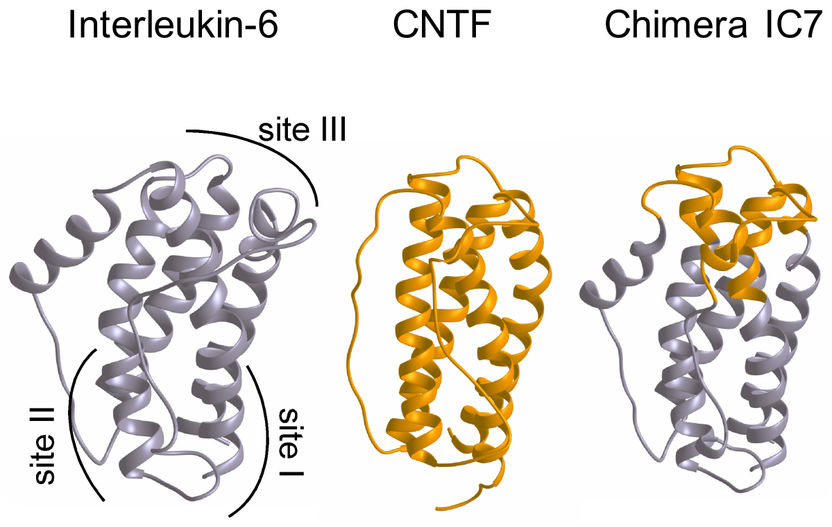The best of both worlds: a designer molecule to combat type 2 diabetes
A team of scientists from Kiel and Melbourne have developed a new protein from two naturally occurring proteins, which has proven very effective against type 2 diabetes in laboratory experiments.

The artificial molecule IC7 (and also the ensuing molecule IC7Fc) largely consists of blocks of Interleukin-6 (IL-6, gray) and a section from a block of CNTF (gold).
Rose-John, Uni Kiel
Scientists led by Professor Stefan Rose-John, a biochemist at Kiel University (CAU) and member of the Cluster of Excellence "Precision Medicine in Chronic Inflammation", have developed and produced a molecule which improves insulin sensitivity in type 2 diabetes in laboratory experiments. The molecule is made up of parts of two naturally occurring signaling molecules, IL-6 and CNTF. Through the new composition, the synthetic protein combines the positive properties of both original proteins, but without their unwanted side-effects. In the future, it could be used as a new type of medication for treating type 2 diabetes.
An estimated 370 million people worldwide suffer from type 2 diabetes, but according to predictions, this number could even double by 2030. The main risk factors for type 2 diabetes are obesity and lack of exercise. With type 2 diabetes, the body cells respond progressively worse to the hormone insulin, i.e. they become more and more insulin resistant. As a result, muscle and fat cells can no longer take up glucose (i.e. sugar), since this process is controlled by insulin. In addition, since it no longer responds to insulin, the liver starts uninhibitedly producing glucose and releasing it into the blood. Thus, the entire blood sugar balance breaks down, and the blood sugar level rises more and more. Two promising molecules with unwanted side-effects
Previous studies have shown that the signaling molecule IL-6 has a positive effect on the metabolic reaction disturbed by type 2 diabetes: in both mice and in humans, it was able to reduce obesity as well as insulin resistance. As such, this could actually be a good active ingredient against type 2 diabetes. However, the signaling molecule acts on the body in many different ways - among other things, it is also pro-inflammatory, and therefore cannot be considered as a medication for the treatment of type 2 diabetes.
In studies, the molecule CNTF has also improved insulin sensitivity and reduced obesity. However, clinical studies have also shown that two-thirds of patients form antibodies against CNTF, rendering the molecule ineffective. Their immune system identifies the molecule as a foreign substance, and tries to fight it. Therefore, both CNTF as well as IL-6 are unsuitable as medication for type 2 diabetes.
The solution: a combination of the two
"In our laboratory, we already designed a molecule some time ago, which consists mainly of components of IL-6, and in which a part has been replaced by a section of CNTF," reported Rose-John, from the Institute of Biochemistry at the CAU. "In exchange with my Australian colleague Mark Febbraio from Monash University in Melbourne, we came up with the idea that this constructed molecule could function similarly to CNTF and IL-6 for type 2 diabetes, but without the well-known unwanted side-effects."
The researchers led by Rose-John originally produced the molecule to find out more about the structure and functioning of the so-called receptor complexes of IL-6 and CNTF. These are twopart structures in body cells, to which specific signaling molecules from outside the cell bind themselves - in this case IL-6 or CNTF - thereby merging both parts and triggering a specific reaction in the respective cell. In its receptor complex, the new molecule incorporates an element from the IL-6 receptor complex and another from the CNTF receptor complex - a combination that does not occur naturally in the organism. This is a decisive advantage: as the new molecule activates a receptor complex, which is not activated by any other molecule, the researchers assumed that it would also not produce an inflammatory response like IL-6. In addition, they hoped that the new molecule would also not trigger an autoimmune response like CNTF, since it largely consists of IL-6 blocks, which the body's immune system recognizes as self.
Promising effect
Rose-John and Febbraio therefore decided to test this molecule in more detail. In Rose-John’s lab in Kiel, they first adapted it so that it is better suited for use in the experiments. The Australian researchers then tested its metabolic effect in detail in the laboratory, and in experiments on animals.
And in fact, the molecule named IC7Fc delivered on its promise: it lowered the sugar content in the blood of obese mice, and restored insulin sensitivity. In addition, mice that were treated with the molecule lost weight. At the same time, IC7Fc caused no unwanted immune system or inflammatory reactions. The researchers have also demonstrated this in human cells. IC7Fc is thus apparently much more tolerable than pure CNTF. "I am delighted with how well it works. Next, we want to test our molecule in clinical trials. If our observations are confirmed, IC7Fc could become a new drug for treating type 2 diabetes," said Rose-John.






















































